Babies’ skin is so soft and sensitive that it often needs special care and attention. Regardless of all the care and protection, babies are usually born with some common skin conditions. Their vulnerable skin is prone to common newborn skin issues like rashes, eczema, bumps, etc. Since it is a common occurrence, it can be easily treated if identified in the initial stages. Some parents may already be familiar with infant skin problems, while others may not. Read on to learn more about the infant skin issues your baby might face.
Common Baby Skin Conditions
Diaper Rash
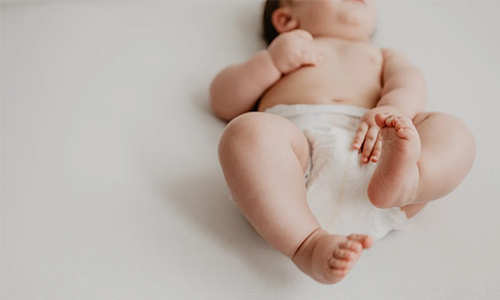
Diaper rash commonly referred to as diaper dermatitis, occurs when moisture in the diaper area causes skin irritation or bacterial growth on the baby’s bottom. It can also occur if the diaper is too tight or if you leave wet diapers on for a long time. Since babies have sensitive skin, they can even be allergic to chemicals in the detergent and wet wipes.
Tips to Avoid Diaper Rash
- Leave the diaper area to air for a while
- Don’t leave the wet diaper on for a long time
- Change it frequently
- Apply ointments that contain zinc oxide or baby cream on the rash.
Baby Acne
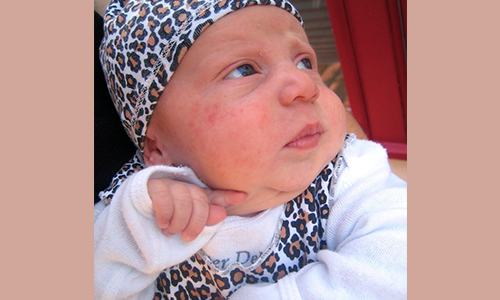
Neonatal Cephalic Pustulosis – Baby acne appears as a small red bump visible on the baby’s face, neck, chest, or back of the babies. It mostly happens during the first few weeks after birth because of the mother’s hormones. Unlike teen acne, it neither leaves scars nor requires any treatment. Simply wash it with clear water and use mild baby soap. Never try to pinch or squeeze the acne. If the acne doesn’t clear up for a long time, consult with a childcare provider.
Cradle Cap
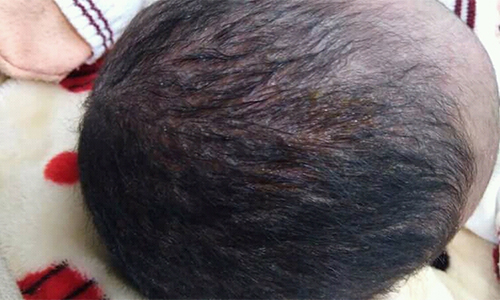
Cradle cap, also known as infant seborrheic dermatitis, affects the baby’s scalp during the first or second month after birth. It appears as yellowish scaly skin or dandruff on the scalp. The overproduction of oil secretion in the sebaceous glands on the baby’s scalp causes cradle cap.
Tips to Avoid Cradle Cap
- Shampoo your baby’s scalp with mild baby shampoo
- Gently brush their scalp to remove the scaly flakes
- If it is stuck tight in their hair, rub a few drops of baby oil and wash it gently
- If it remains for long, consult a health care provider.
Eczema
Eczema, also referred to as atopic dermatitis, reflects as dry, itchy, scaly red patches on the skin, often around babies’ or toddlers’ knees or elbows. This condition occurs if the baby has a family history of asthma, allergies, and atopic dermatitis. The baby’s sensitive skin is prone to such skin infections and diseases.
Tips to Prevent Eczema
- Switch to fragrance-free detergents and soaps as harsh chemicals may irritate a baby’s sensitive skin.
- Use cotton and soft fabrics and avoid synthetics.
- Apply natural fragrance-free oils, to moisturize your baby’s skin.
- Prefer cool climatic conditions, avoid hot environments as they can trigger eczema.
- Keep your surroundings clean and dust-free.
Erythema Toxicum
Erythema toxicum is a common skin condition that occurs after birth. It is a small white or yellowish bump that usually appears on the face, arms, or legs. This skin condition is neither contagious nor dangerous. Additionally, erythema toxicum fades eventually, so treatment is not required.
Heat Rash or Prickly heat
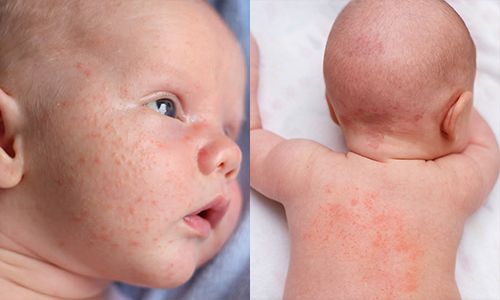
Heat rash or prickly heat, is a common infant skin condition that occurs during hot climatic conditions. It can be seen around the neck, diaper area, armpits, and skin folds. It causes itching and makes the baby irritable. To avoid prickly heat, keep your baby in cool temperatures and dress them in soft loose-fitting clothes. Remember that over-dressing can also cause prickly heat, so avoid layering them with thick clothes
Milia
Milia refers to the white tiny bumps or pimples that appear on the nose, chin, and cheeks. They are harmless. Milia don’t require any specific treatments and can disappear eventually.
Baby Yeast Infections
This infant skin problem arises after a round of antibiotics. Yeast infections appear on different areas of the baby’s skin. On the baby’s mouth, it appears like dried milk on the tongue and mouth. Yeast diaper rash affects the diaper area, it appears as red rashes, sometimes with tiny bumps and pimples on the edge. An antifungal cream or anti-yeast liquid is recommended to treat baby yeast infections.
Jaundice
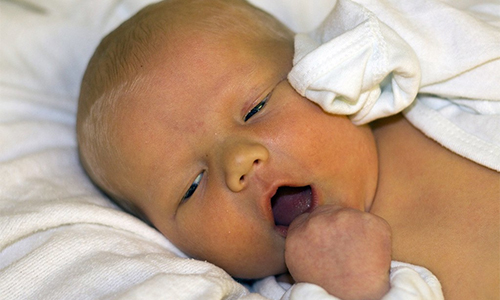
The yellow coloration in the baby’s skin, lips, and eyes are symptoms of jaundice. It arises two to three days after the baby’s birth and is a common skin issue in infants. It occurs as a result of excessive production of bilirubin. The baby requires immediate medication for the severity of jaundice.
Bottom line
Rashes, scars, and bumps are some common infant skin conditions that can be cured. Most newborn skin issues don’t require any medications as they disappear in a few days. In case you sense anything serious, don’t hesitate to approach a child’s health care provider as they provide the right treatment.

